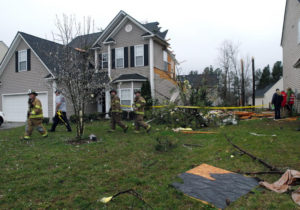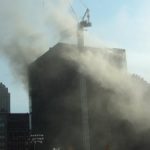Everyone will need to use a washer and dryer at some point; gone are the days that we wash everything by hand. But keeping these appliances in good condition as well as maintaining the safety of your family and home are crucial. Here are some dryer fire tips to keep in mind to prevent the risk of disasters.
Installation by a Professional

To ensure that your dryer is installed properly, it is best to have it installed by a professional technician. They will be knowledgeable about numerous units, including those that use gas and electricity as well as how they work with washers. They will also be familiar with the manufacturer’s instruction manuals, including installing a vent pipe.
If asked, a professional can explain how preventing bends in the pipe will reduce the amount of lint buildup. If the vent is located far from the dryer, they can also install a dryer vent. This automatic device will speed up airflow through the duct each time the dryer runs. Lastly, they will be able to identify and remove any potential hazards that can start a fire in the long-run.
Frequent Servicing
Most professionals will say that the most common cause of dryer fires will be failure to clean them. If you pull them out and check behind them, you may find a buildup of lint. Make sure that it’s cleaned and inspected annually, including the vent and hose for any damages at least two times each year.
Consider scheduling a professional to clean out the interior to minimize the accumulation of lint as well as provide a professional opinion of its safety status. They can also inspect the exhaust and venting system. To ensure that this is done properly, hire a certified professional.
Remove All Flammables from the Area
In addition to lint, there are a number of household items that should stay clear of the dryer. This includes debris, clothing, paper towels, boxes, etc. Make sure to remove these before they pile up and create a hazard. It may seem like a hassle but a vacuuming job will certainly be easier than cleaning up the aftermath of a fire.
Clean the Lint Filter After Each Load
The most common causes of fires include the ignition of lint and debris. As they collect within the dryer, they sit on the heating elements and can catch on fire if they reach a certain temperature, such as 550 degrees.
Make sure to get in the habit of cleaning the lint screen after each cycle. Also make sure to wipe down the interior of the dryer that may also hold additional lint. It’s not as important but still a good idea.
Always make sure that a cycle is never run without a lint filter as it is the dryer’s biggest defense against fires. Although it’s common sense, forgetting to put it back in has happened before.
Use Only Rigid or Flexible Metal Venting
Many dryer manufacturers will specify the use of flexible or rigid metal venting material to be used for proper drying time and air flow. If any accordion-type ductwork is used, lint can become trapped, increase blockages, and create clogs. All plastic or coiled wire foil dryer venting should also be replaced right away with rigid, non-ribbed metal ducts. Make sure these items are purchased from a trusted vendor as it will be key to ensure the safety of your unit.
Make Sure Exhaust Vent Pipe is Clear
Most dryer fires are the result of blocked dryer vents. It can be difficult to know when the vents are clogged but many people don’t even notice that the vents will need to be cleaned. But it’s important to know that lint can build up easily within the homes and will cause a dangerous problem.
In between inspections, clean the outside exhaust vent on a regular basis. Any time the dryer is running, make sure that airflow is not restricted. If you can’t feel any air coming out of the vent, there is a good chance that it’s blocked.
Make sure to clean it out and reconnect the ducts on the outside of the dryer. If you’re not sure where to begin, consult with the owner’s manual or hire a professional.
Never Overload
Not many people like doing laundry, especially with a busy schedule. But procrastinating this chore can make it tempting to overload the dryer, which is a serious hazard.
Putting too many items in the dryer is hard on the unit and can eventually lead to it breaking down. This can add up in repair costs and even overworking the machine. When this happen, any friction can light up a spark.
Not overloading your dryer is probably the easiest to avoid. Just make sure not to fall behind on washing your clothes, but if you do, never rush to get them all washed. Even if you have a busy schedule, take the time to split your load into 2-3 cycles if needed.
Inspect Gas Lines
During inspections, make sure that the gas line is inspected and connected properly to prevent leaks and intact. Any professional would know that leaks are extremely dangerous and can cause fires at any second. If you find a burning smell when running your dryer, make sure to shut if off right away and call the manufacturer. If there is a gas leak, stay out of that area.
Use the Right Plug & Outlet
Dryers can’t just operate from any outlet; they use a special plug and outlet that are stated in the manufacturer’s instructions. One way to make sure that this is done is to have a licensed professional install the dryer for you.
Also make sure that everything is connected properly and make note of any changes. If anything looks damaged, loose, or discolored, turn the unit off right away. Overloaded circuits can also lead to blown fuses and even a house fire.
Never Run the Dryer When You Leave Your Home or Are Sleeping
It’s convenient to simply load up the dryer before heading off to work, errands, or bed. But if a house fire starts while you’re gone, it likely will have consumed the property by the time you get back.
For your own safety, only run the dryer when you are home and awake. Also keep a fire extinguisher close in case of an emergency.
At any time the dryer is not working properly, it will increase the risk of fire. Always look for signs of this as well as increases in the risk of fires. Key signs to look out for will include a missing lint trap, the top of the dryer being hot to the touch, and clothes taking longer to dry. Or if the clothes come out too hot, the dryer is overworked.
Key Tips to Remember
- Never forget to clean the heat vents on the back of the dryer.
- Pull out your dryer and clean the vents in the back with a vacuum
- Keep your clothes dryer serviced
What to Do In Case of a Dryer Fire

There are a number of steps that can be taken to prevent dryer fires, such as those listed above, but life gets in the way and things happen. If you were to experience a dryer fire, try to put it out yourself with a fire extinguisher. If you are unable to do this yourself, call 911 right away to have it put out.
As soon as the flames are extinguished, the soot and smoke byproducts must be removed quickly to prevent permanent damage. Make sure to call a professional fire restoration provider, one that is licensed and experienced.
One such provider includes ServiceMaster. Available nationwide, these professionals are available 24/7 and will respond immediately to all fire emergencies.
Using professional equipment and products, these fire damage cleanup professionals will remove any soiled porous materials, rebuild the structure, and clean the remaining hard surfaces and contents. They will also work with your insurance provider, if needed, to expedite the claims process.
Finally, you will be able to return home with the peace of mind that the affected area is fully restored.



